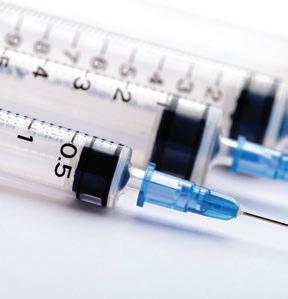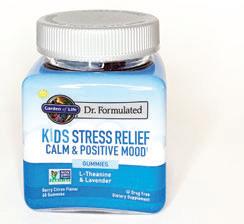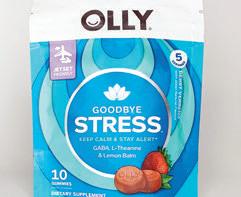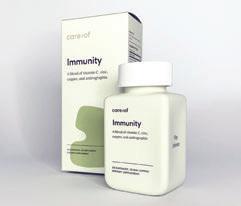
7 minute read
ANNUAL PACKAGE DESIGN GALLERY
Modular: The Modern Way of Manufacturing Injectables
MELISSA GRIFFEN, CONTRIBUTING EDITOR
1. Treatments are moving from hospital to home, requiring user-friendly injectable devices. Oncologics are one sector driving growth. 2. Modular manufacturing allows for a range of products in a single facility with faster changeovers and improved OEE. 3. Modularity may allow companies to fulfill multi-product campaigns requiring different production schedules.
TOP THREE TAKEAWAYS
Modular manufacturing is on the rise in the pharmaceutical industry. The last few years have shown an increase of interest in modular solutions for a variety of uses and Stevanato Group—a provider of integrated systems for pharma and healthcare—projects that this tendency will only continue, especially in injectables.
This popularity is due to the flexibility offered by modular manufacturing, allowing pharmaceutical processors to produce a range of products in a single facility with faster changeovers and improved overall equipment effectiveness (OEE). Modular manufacturing breaks down a system into discrete component “modules” that perform specific roles and can be integrated into or removed from the overall structure at will.
The following factors are driving this movement in the injectables market: • Many treatments are moving from hospital to home, reducing costs for healthcare providers and increasing patient comfort. This requires the need for user-friendly injectable devices, which has been further exacerbated by the COVID19 pandemic. • The demand for auto-injectors and pen injectors is skyrocketing as lifestyle-related diseases, such as diabetes, become more widespread in both developed and developing countries and as the niche of targeted small batch and personalized medicines, including oncological formulations and certain biologics, grows. This is driving the need for more mobile, less intrusive, and simpler solutions that remain cost-effective, which in turn demands flexibility on the manufacturing side.
These self-administered options allow patients to treat themselves more independently and autonomously than ever in a safe manner. As Editor Aaron Hand says in Burgeoning Auto-Injector Market Demands Flexible Production Options, “Auto-injectors help avoid common risks associated with self-administration via syringes, such as incorrect dosages and misuse, serious injuries, and discontinuation of treatment.”
The benefits for healthcare providers and patients are clear. As injectables continue to become more customized and self-administered, manufacturers will need to modify the design, engineering,
and production of their assembly line equipment to meet these and future demands. This will in turn benefit manufacturers— contractors and service providers in particular, who will need to prove adaptable—as the industry will continue to evolve with varying shapes, sizes, and materials of injectables as well as in product volumes, demand, and sub-categorical issues like target audience differentiation. Production processes will need to be time-efficient and customizable.
A Pharmaceutical Networking article, Defining ideal modular design for effective pharma packaging, seconds this perspective and explains that the modular design must be adapted to the existing development process and embedded into ongoing operations during implementation in order to minimize adaptation demands which will surely come.
Automation and pharma 4.0
Stevanato Group outlines characteristics of modular manufacturing that assembly machinery needs in order to keep up with the needs of modern combination products: fast format changeover to reduce costly downtime, flexibility to allow reduced CAPEX investments and achieve shorter time to market, and scalability for additional modules to meet increased volumes.
Another factor Stevanato Group emphasizes is automation. Though lower volumes of product are typically required with auto- and pen-injector production, efficiently switching to wider-scale production efforts can be necessary. Automating processes can also reduce human intervention and further decrease production downtime.
The company explains that automation becomes valuable through its reliability, precision, repeatability, and process optimization. The greatest benefits come from incorporating automation into the very beginning stages of the development process, offering an alternative to the prototyping phase with a benchtop through a semi-automatic pilot line. This offers inherent scale-up advantages, allows early de-bugging, and mitigates future risks as the technologies used from pilot line to large-scale, fully automated line are the same.
Says Stevanato Group, “Involving equipment partners with modularity experience from the early stages offers a distinct advantage, since they’ve seen for themselves how initial development work is crucial for establishing early proof of principle and validating the assembly process.”
Looking at containment systems and automation scale-up early on are key, in part due to injectables’ product-specific complexity.
In Industry 4.0 with a Pharma Focus, Pat Reynolds covered the efforts of the Marchesini Group in the life science space, noting, “…once processes are digitized, it opens the door to other exciting possibilities such as machine learning, condition monitoring, remote-access monitoring, and, ultimately, the smart factory. In the smart factory, operations are carried out with minimal manual intervention, high reliability, and maximum flexibility. The automated workflows, synchronization of assets, and improved tracking and scheduling in the smart factory lead to increased yield and quality along with reduced cost and waste.
“Predictably enough, the pharmaceutical industry is anything but immune to the impact of IoT and Industry 4.0, trends that are transforming pharma manufacturing at a rapid pace.”
This is echoed by Pharmaceutical Networking which further builds on the potential for Industry 4.0 concepts in modular manufacturing in pharma, such as shared data, artificial intelligence (AI), and increased connectivity enabled through the Internet of Things (IoT).
Systems incorporating these concepts and created by collaborative efforts from Dividella—a supplier of cartoners and secondary packaging machines for the pharmaceutical and biotech industry–and Medipak Systems—a system provider for the pharmaceutical industry—also use the “Plug & Produce concept of vertical integration that imposes a standardized interface between machines in production and the production control system.” This allows modules and production lines to be connected or disconnected through plugging a drive into a computer via a USB interface.
This setup has further allowed Medipak Systems to create advanced systems that include smart packaging, Enterprise Manufacturing Intelligence (EMI), smart devices, and condition monitoring and predictive analytics. These advancements improve end-user experience, user-friendliness for operators, and allow superior decision-making by producers.
Benefits of the modular format
There is a range of benefits that come from modular manufacturing, beyond adapting to market demands, fast changeovers, improved OEE, and up scaling options with automation and plug and play expansions. Modularity can also: • Deliver standardization—as modules are simplified, produced more economically, and made reusable—and customization by tailoring systems to individual and specialized demands. • Reduce costs in both implementation and operation. • Ensure faster production and delivery, and when machine utilization rates are high, offer high return on investment within a short timeframe. • Allow manufacturers to meet the need to deploy manufacturing regionally, reduce the cost of goods sold (COGS), increase capacity utilization and speed-to-market, and fulfill multi-product campaigns requiring different production schedules. • Encourage engineering and production teams, through its synergy-centric nature, to collaborate by planning in parallel for near-term and longer-range scaling needs.
Package Design Gallery
This year’s gallery featured many calming and minimalist aesthetics, signifying a consumer looking for relief at home and work—outside of the clinical setting.
KEREN SOOKNE, DIRECTOR OF EDITORIAL CONTENT
Each year, Healthcare Packaging evaluates an array of over-the-counter product packaging designs, assessing the pros and cons from a user perspective.
Trends on the Shelves + While perhaps not pandemic-related (with formulation, package design, and commercialization often taking years), there was a plethora of stress-fighting, anti-anxiety, and calming products, even for children. + Blues, greens, and serene imagery were featured more prominently than last year. + The minimalist trend continued with whitespace on labels and cartons, and casual copy for a “conservation” with consumers. + Larger mainstream brands used nature-inspired images and touted fewer ingredients or “what’s absent” from the product. + Many had clear disposal instructions and more packages on shelves were recyclable.
Garden of Life Kids Stress Relief
+ A shrink sleeve makes the most of the real estate, offering founder’s story, icons for expected effects, and symbols for gluten-free, recyclability, renewable energy use, and more + Calming sea and cloud images; suggested use lets parents know daily dosage + Square jar stands out on shelf; wide mouth child-resistant (CR) lid was easy to open
• The sleeve was a bit curved on the bottom of two panels, which caused copy to distort slightly but it remained legible • Customers would presumably need to remove the sleeve before recycling

Olly Goodbye Stress Gummies
Noho Health Inc. care/of Immunity
PROS
NOTES + Bright standup recloseable pouch features serene blue and turquoise hues + Servings per package are clear; touts “Jet Set
Friendly” size + Matte pouch with spot gloss/foil on front and back gives high-end look; notches for easy opening + Usage, warnings, and symbols on back are spaced well
• Disposal is not specified

La Mend Inc. The Good Patch
PROS + Matte sky blue recloseable pouch with dreamy icons and whitespace (more easily accomplished when Drug
Facts are not required) + Back panel is well-organized with lines separating ingredients, directions, warnings, a link to a “surprise,” and more
PROS + Matte outer carton in soothing green; matches matte rectangular easy-to-grip bottle + This is part of a colorful product family for various needs; enclosed leaflet showcases product combinations + Glossy info and imagery are printed on bottle; instructions are small but contrast well against simple background + Minimal abstract graphics allow for conversational, explanatory copy without a “busy” feel
NOTES • Carton says “please recycle me” on bottom, but consumers may not know how to recycle the bottle (#7) depending on local infrastructure.










